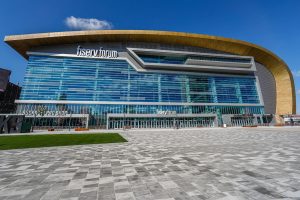In Year Two, Milwaukee Bucks’ Fiserv Forum Is in the IP Game Early
Highly flexible video-production environment produces vivid in-venue visuals
Story Highlights
The closure of the BMO Harris Bradley Center, home of the NBA’s Milwaukee Bucks since it opened in 1988, elicited more fond farewells from both fans and players than some sports venues. But it was definitely time for a change: 30 years old when the team ended its 2017-18 season there, the facility was far creakier than the typical basketball arena, at an average age of 11.4 years, according to a Minnesota State University study.

Fiserv Forum’s 24-display videoboard is part of 52-display “super-system” featuring more than 16 million LEDs.
The flagship feature of its replacement, the 17,500-seat Fiserve Forum, which opened in August 2018, reflects how much sports events have come to rely on vivid in-venue visuals. The NBA’s largest-of-its-kind centerhung scoreboard, a 24-display behemoth providing 3,922 sq. ft. of video display, covers more than three-fourths of the court below. It’s part of a 52-display “super-system” featuring more than 16 million LEDs, including additional outdoor displays, all fabricated by Daktronics.
Into (ST) 2110 in 2018
A year on, with the Bucks beginning their second season in the arena, the central scoreboard is still breathtaking, but it also reveals how quickly media-technology standards evolve and how those who implement them have to be aware of that, even with relentless demand to keep venues on the cutting edge.
When venue-systems designer WJHW and CAA/ICON, the new venue’s strategic-management consulting firm, approached AV-systems integrator Comprehensive Technical Group about developing a solution based on the SMPTE 2110 IP standard, that standard was still a work in progress. For instance, there were no monitors with IP inputs compatible with the SMPTE 2110-20 standard for uncompressed video over IP. So CTG moved forward with a hybrid-IP infrastructure. However, all the routing in the Fiserv Forum is IP, and 3GSDI gateways are used to handle those devices that were not SMPTE 2110-ready when the system was being installed and commissioned.
Everything else on the venue’s AV-tech list was equally close to the cutting edge. CTG partnered with Imagine Communications to provide the SDNO core routing system and EPIC multiviewers, with EVS for XT4K 1080p and super-slo-mo replay system with XS4K playback servers, and with Ross Video for Acuity and Carbonite switchers and six channels of Xpression live-graphics and playout systems.
The Carbonite switchers are deployed for subswitching sources to destinations, and the six channels of Xpression CG live-graphics and playout systems provide stunning 1080p 3G content to the Daktronics displays.
The EVS XT4K units are the replay system for showing game action captured by the Grass Valley LDX 86 HiSpeed 3X for the best camera angles for the play involved. The XS4K units record the production’s primary program, in addition to postgame interviews, and are also used for clip and motion-graphic playback during the game.
Image Video’s TSI-4000 Control System also assists with multiviewers and tally.
Worth the Risk
It might have seemed somewhat speculative at the time, given how rapidly IP standards were evolving. It turned out well, however, according to the Bucks.
“I’m glad we took the risk and went with the SMPTE 2110 IP video system,” says Johnny Watson, director, live programming and entertainment, Milwaukee Bucks. “We have had a lot of other teams come to visit and see our facility, and they are blown away by the fact that we are all-IP.”
(The Bucks’ fans apparently feel the same way.)
The Fiserv Forum’s video is an accomplishment on a number of levels — literally. “One of our biggest victories was to get a control room not in a bunker on the Event Level [and] to have it in a location with a view of the bowl. Our view is outstanding,” notes Watson. “Our sightlines are amazing to be able to produce the show, and it’s great that we have the audio guys there as well. When we open our windows, you can feel the vibe in the building, which helps us a lot on game night.”
There is a lot of technology to help build exciting in-house productions during the games, including seven Grass Valley LDX86 POV cameras, which are used in reverse, game, and slash positions; two on-court handhelds; six channels of Ross Xpression; and a Wave Central wireless system. Besides the videoboards, the venue has more than 800 television sets, all managed from the control room. Direct camera feeds are shared with broadcast trucks. It’s a toolkit that Watson says can create an in-venue experience that equals what fans can see at home and underscores what sports coverage can be.
“What we were looking to accomplish was basically to take our presentation beyond what was possible in our old facility,” he explains. “My philosophy is that you want the board to be impactful with a live feed of incredible image quality, not only game action but also crowd shots. Just having the number of screens that we have allows us to do some unique content that the fans can use throughout the game. That was really important to us.
“I think all of those things combined into a fantastic design,” he continues, “and we are still developing new concepts and working to constantly improve what we do with it. It seems like we still have a way to go to utilize the total capability of the system, but that’s the beauty of this whole process: to learn and to grow and to see what we can unleash with these capabilities.”

